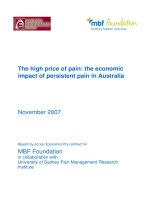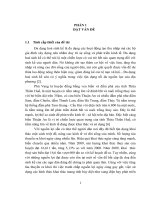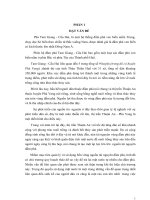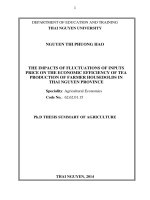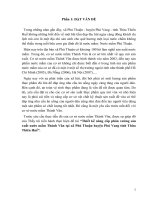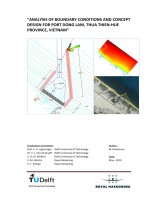THE ECONOMIC EFFICIENCY OF SHRIMP FARMING IN THUAN AN TOWN, PHU VANG DISTRICT, THUA THIEN HUE PROVINCE
Bạn đang xem bản rút gọn của tài liệu. Xem và tải ngay bản đầy đủ của tài liệu tại đây (411.5 KB, 60 trang )
HUE UNIVERSITY
COLLEGE OF ECONOMICS
THE ADVANCED PROGRAM
UNDERGRADUATE THESIS
THE ECONOMIC EFFICIENCY OF SHRIMP FARMING IN THUAN AN
TOWN, PHU VANG DISTRICT, THUA THIEN HUE PROVINCE
NGUYỄN ĐẶNG PHƯỚC TÀI
Hue, June 2016
HUE UNIVERSITY
COLLEGE OF ECONOMICS
THE ADVANCED PROGRAM
UNDERGRADUATE THESIS
THE ECONOMIC EFFICIENCY OF SHRIMP FARMING IN THUAN AN
TOWN, PHU VANG DISTRICT, THUA THIEN HUE PROVINCE
Name of student: Nguyen Dang Phuoc Tai
Name of supervisor: Assoc Prof, Dr Bui Dung The
Class: K45 Agricultural Economics - Finance
Academic year: 2011-2016
Hue, June 2016
ACKNOWLEDGEMENTS
It is important to realize that without the help of all the organization and people I
met with, I would not have been able to complete my first Bachelor’s thesis. Hence, I
am deeply grateful to many people for their help and support during the various stages
of writing this thesis.
First and foremost, I would like to express my sincere appreciation to
Assoc
Prof, Dr Bui Dung The, my thesis supervisor, for his enthusiasm and encouragement
at every stage
of my thesis. I could not have imagined having better adviser and
mentor for my teacher. Besides,
I would like to thank all local staffs in Thuan An
town, who helped me in collecting data process. Likewise, my sincere thanks also
go to all teacher in Agricultural Economics- Finance Department.
ABSTRACT
The thesis is examining economic efficiency of shrimp farming in Thuan An
town, Phu Vang district, Thua Thien Hue province. The secondary data for estimating
regression models on relationships between the input factors such as the density of
breeds, the food cost, the labor cost, disease prevention, the age of household head, the
education level of household, the acreage of household are acquired from 2016.
Summary results collected from shrimp farmer review and survey in Thuan An town.
By the use regression model of Cobb Douglas function in combination with the
statistics methods and use of the evaluation indicators of economic efficiency, the
study shows the economic efficiency shrimp farming, economic efficiency compare
with two main farming forms (high-tide pond and low-tide pond). Even though shrimp
farming here is a key sector, it still meets difficulties because of subjective and
objective factors such as: unfavorable weather, technical farming. Besides, farmers are
yet to use input factors appropriately.
CONTENTS
LIST OF ABBREVIATIONS......................................................................................i
LIST OF TABLES.......................................................................................................ii
PART I: INTRODUCTION..........................................................................................................................1
1.1. State of problem..........................................................................................................................1
1.2. Purpose of research.....................................................................................................................1
1.3. Scope and Delimitation................................................................................................................2
1.4 Research methodologies..............................................................................................................2
1.4.1. Data collection method.......................................................................................2
1.4.2. Data analysis method:........................................................................................2
1.4.5 Indicators reflecting economic efficiency of shrimp farming:...............................3
PART II: CONTENT OF RESEARCH............................................................................................................6
Chapter 1: Overview of Research Issues.................................................................................................6
1.1 Theoretical literature review........................................................................................................6
1.1.1 The Concept of economic efficiency...................................................................6
1.1.2 Economic efficiency in Aquaculture and Shrimp farming:...................................7
1.1.3 Method of determining the economic efficiency..................................................8
1.2 The role and characteristics of shrimp farming............................................................................9
1.2.1 The role of shrimp farming..................................................................................9
1.2.2 The characteristics of shrimp farming..................................................................9
1.3 Practical basis.............................................................................................................................12
1.3.1 General shrimp farming situation in Viet Nam 2015..........................................12
1.3.2 Shrimp farming situation in Thua Thien Hue.....................................................13
Chapter 2..............................................................................................................................................15
Basic Situation in Thuan An Town........................................................................................................15
2.1 Characteristics of Nature............................................................................................................15
2.1.1 Geographical location........................................................................................15
2.1.2 Topography, land..............................................................................................15
2.1.3 Weather& Climate............................................................................................15
2.2 Socio-Economic Conditon...........................................................................................................16
2.2.1 Labor and Population situation of the town........................................................16
2.2.2 Using land situation in town..............................................................................18
2.2.4 The result of shrimp farming in town.................................................................20
2.3 General assessment of the basic situation in Thuan An Town....................................................21
2.3.1 Advantages.......................................................................................................21
2.3.2 Disadvantages:..................................................................................................21
2.4 The result and efficiency of shrimp farming in Thuan An Town.................................................22
2.4.1 General information of households surveyed.....................................................22
2.4.2 The investment of shrimp farming situation in households surveyed..................24
2.4.3 Analyzing production cost of households in studied area...................................25
2.5 Results and economic efficiency of shrimp farming household surveyed..................................33
2.5.1 Farming area, yield and production of the households surveyed.........................33
2.5.2 The results and efficiency of shrimps farming of households surveyed in 2016..34
2.6 Analyzing factor affecting the efficiency of shrimp households surveyed..................................39
2.6.1 Dividing Group by the cost of food according to 2 types of pond.......................39
2.6.2 Regression model..............................................................................................43
Chapter 3..............................................................................................................................................45
ORIENTATION DEVELOPMENT AND SOLUTIONS..................................................................................45
3.1 Orientation development...........................................................................................................45
3.2 SOLUTIONS:................................................................................................................................45
3.2.1 Solution to local government.............................................................................45
PART III: CONCLUSION AND RECOMMENDATION................................................................................48
3.1 Conclusion..................................................................................................................................48
3.2 Recommendation.......................................................................................................................49
REFERENCES:........................................................................................................................................50
LIST OF ABBREVIATIONS
TC
Total Cost
IC
Intermediate Cost
GO
Gross Output
VA
Value Added
MI
Mixed Income
Pr
Profit
VND
Viet Nam dong
Ha
Hectare
Mil
million
i
LIST OF TABLES
Table 1: Shrimp farming situation in Thua Thien Hue in 3 years (2013-2015)......................................13
Table 2: Population and labor situation of Town in 2 years (2014-2015).............................................17
Table 3: Using land situation (2015).....................................................................................................18
Table 4: Shrimp farming situation in Thuan An town in 2015, 2014.....................................................20
Table 5 :General information of the household surveyed in 2016.......................................................23
Table 6: Investment situation of household surveyed in 2016.............................................................24
Table 7: Intermediate cost of household surveyed devided by type of pond in 2016(average/ha).....27
Table 8: Production cost of households surveyed according to 2 types of pond in 2016 (average/ha) 32
Table 9: Area, productivity, and yield in 2016......................................................................................33
Table 10: The results and efficiency of shrimp farming in average per ha of households surveyed in
2016......................................................................................................................................................35
Table 11 Comparing the results and efficiency shrimp farming average/ha
of household surveyed in 2016............................................................................................................37
Table 12 : Dividing groups by the food cost according to high-tide ponds...........................................42
Table 13 : Dividing groups by the food cost according to low-tide ponds............................................42
Table 14 : Factors affecting Shrimp farming productivity.....................................................................43
Table 15: Investment level according to material unit.........................................................................51
Table 16: Factor affecting shrimp farming productivity........................................................................51
ii
PART I: INTRODUCTION
1.1. State of problem
Thua Thien Hue is a central coastal province which has great potential for
aquaculture development; with the advantage of Tam Giang - Cau Hai that is longer
than 70km, 22.000ha area, rich in flora and fauna, and the largest coastal lagoon
system in Southeast Asia. This is where the ideal conditions are blessed for the
development of aquaculture, especially commercial shrimp farming. Tam Giang-Cau
Hai spreads over 5 districts of Phong Dien, Quang Dien, Huong Tra, Phu Vang and
Phu Loc.
Thuan An Town, Phu Vang district, Thua Thien Hue Province is located along
the Tam Giang Lagoon. Aquaculture, especially, shrimp farming has started long time
ago but only really developed since 2002 and has become a key economic sector in the
locality helping create jobs and raise incomes for people simultaneous improve of
socio-economic foundation.
Nonetheless, Aquaculture here still has shortcomings. Most of shrimp farming
here most are spontaneous, low production levels, and are not synchronized.
Movement of shrimp farming is mainly based on experience which shows little interest
in technical issues, then do not bring high economic efficiency for farmers. Besides,
the ponds, over the years, are not focused on rehabilitation treatment making the
disease occurs continuously, affecting farming results. On the other hand, in recent
years, the disease situation and the pollution of water sources are increasingly more
serious that affect the productivity and efficiency of shrimp.
Stemming from that fact, I chose the theme "Economic efficiency of shrimp
farming in Thuan An Town, Phu Vang district, Thua Thien Hue province” as the
subject of my thesis.
1.2. Purpose of research
Reviewing theoretical and practical basis about economic efficiency in general,
and shrimp farming in particular.
Assessing the status of production, results and efficiency of shrimp farming
1
Identifying the factors that affect the results and efficiency of shrimp farming in
the studied area.
Proposing solutions mainly to improve economic efficiency in Shrimp farming
in Thuan An town
1.3. Scope and Delimitation
Research area: Thuan An Town, Phu Vang District, Thua Thien Hue Province
Time of studying: Economic efficiency of shrimp farming in Thuan An town in
the period of time from January to April in 2016.
1.4 Research methodologies
1.4.1. Data collection method
Secondary data: based on data belonging to Statistical agency (department of
Agriculture and Rural development in Phu Vang district), Department of Aquaculture,
data from the statistical yearbook in district 2015. Also the thesis used relevant book,
internet
Primary data: Primary data was collected from interview shrimp farmers with
questionnaire. According to report, there are 140 households in 11 villages in Thuan
An town who farm shrimp. By sampling method, i randomly selected 3 households
applying high-tide pond farming and 2 households applying low-tide pond in every
villages (nearly 24% of every villages). In which, I also selected 3 typical shrimp
farming households in 3 villages according to recommendation of local staff. There are
58 households selected in total.
1.4.2. Data analysis method:
1.4.2.1 Descriptive statistical method:
Based on the primary data and secondary data collected, using descriptive
statistical method to synthesize data, then analyze and assess indicators by time.
Furthermore, Thesis also used economic accounting methods to analyze, compare
results and indicators of economic efficiency of local and shrimp farming households
surveyed.
2
1.4.2.2 Regression method
To assess the influence of factors to the productivity of the shrimp farming
process, in the process to implement the project I was using the Cobb-Douglas
production function with following form:
Y= A.X1α1X2α2X3α3X4α4X5α5eβ1D1
αi: (i = 1-5): coeficient exponent of the independent variable
βj: (j = 1-2): coefficient exponent of the dummy variable
Y: Shrimp farming Productivity (kg/ha)
A: intercept
X1: Density of breeds ( unit/m2 )
X2: Food (kg/ha)
X3: disease prevention (million VND/ha)
X4: labor (labor/day)
X5: year of experiences (year)
D: dummy
D1: pond type ( D1=1, high-tide pond; D1=0, low-tide pond)
1.4.5 Indicators reflecting economic efficiency of shrimp farming:
Shrimp industry is like the other business industries, economic efficiency is the
top standard of the investment decisions of the business as well as social. However, in
the production process there is always people gaining profit, loss, or breakeven. If
farming households apply the right techniques, have enough capital, invest properly,
have good experience, they will gain high profits, which would accumulate and
expand production process. In contrast, they will meet break even or lost money, or
fall into indebtedness. Therefore, the assessment of economic efficiency is very
important, helping shrimp farmers can see the status of the production process in order
to provide solutions to improve or maintain manufacturing efficiency
1.4.5.1 Indicators reflecting productive power:
Total Cost (TC) is regularly full cost of material and cost of services used in the
production of manufacturing goods and other service activities of enterprises in a
certain period (usually for one year ), including depreciation assets and wages.
3
Intermediate Cost (IC) is an integral part of the total cost including costs for
manufacturing and services (excluding depreciation fee) and the cost of services
(including material and non-material services) used in the process of producing
material goods and other service activities of enterprises in a certain period
Intermediate cost of agricultural activities includes:
Material expenses: cost of breeds, fertilizer, fuel, food, regular repair
amortization expenses ...
Cost of services: plowing expense, hiring employee, spending money on
irrigation charges ...
1.4.5.2 Indicators reflecting production result:
The total value of household production: GO (Gross Output) is the total value
of products produced by households, defined as the sum of the products is specified by
value.
n
GO =∑
Pi Qi
i =1
Including:
Qi is the volume of product i.
Pi is the price of product i.
Value added (VA): is the whole last result of the activity of shrimp farmers in a
certain period (usually 1 season or 1 year). It is calculated by the difference between
total revenues (GO) and intermediate costs (IC) investment per unit of area.
VA = GO – IC
Mixed income (MI): is an indicator of the results of household’s farming
activity without deducting family labor.
MI= VA – (depreciaton assest + tax, fee)
Profit (Pr): the gross ouptut minus total production costs.
Pr = GO – TC
1.4.5.3 Indicators reflecting economic efficiency
Value added per intermediate cost (VA/IC): reflecting 1 dong intermediate cost
can create how many value added dong
4
Gross output per intermediate cost (GO/IC): reflecting 1 dong intermediate cost
spent in production can create how many gross output dong in a certain period of time
Mixed income per Total cost (MI/TC): reflecting 1 cost can create how many
mixed income dong for households
Profit per Total cost (Pr/TC): reflecting 1 cost spent can create how many profit
dong.
5
PART II: CONTENT OF RESEARCH
Chapter 1: Overview of Research Issues
1.1 Theoretical literature review
1.1.1 The Concept of economic efficiency
In the manufacturing process, the first target for businesses or people is to
achieve maximum profit. To do so, businesses must constantly find solutions to
improve economic efficiency and optimal choice to use the resources of the society.
The resources which are used mainly in the production and business processes are
land, capital, labor and natural resources ... Nowadays, however, the resources are
increasingly scarce and depleted while human demand on these resources is gradually
increasing. Therefore, the efficiency of using these resources is essential. On the one
hand, it solves the scarcity of resources. On the other hand, it contributes to increase
profit for people. When it comes to the efficiency of resources, we often say to
efficiency of using these resources. For a better understanding, we learn some
following concepts of economic efficiency.
Economic efficiency is a particularly important category, it shows results in
per-unit costs of production industry. In terms of forms of economic efficiency, it is a
measure to compare the results produced to the cost spent. More specifically,
economic efficiency is a term typically used in microeconomics when discussing
production. Production of a unit of good is considered to be economically efficient
when that unit of good is produced at the lowest possible cost (Moffet, 2015).
Comparative relationship here is the relative comparative relationship. On the other
hand, the absolute relationship is meaningful only in a very narrow range.
In other words, the concept of economic efficiency is understanded briefly:
economic efficiency reflects the quality of economic activity and is determined by the
ratio of the results achieved and the cost spent to achieve that result.
E= R/C
E: economic efficiency of a certain economic phenomenon
R: The result of a certain economic phenomenon
C: The cost of a certain economic phenomenon
6
According to such concept, we can fully calculate the economic efficiency of
the movement and continuous change of the economic activity, regardless of the size
and speed of their different volatility
From the above concepts we can understand the economic efficiency in
agriculture is a combination of consumption of labor and materialized labor to produce
agricultural products. It is expressed by comparing the results achieved with labor cost
volumes and material cost. In determining the economic efficiency of agricultural
production, we must take into account the use of the land, potential sources of
agricultural production including production capital, labor capital and land.
Today, “Economic efficiency” is the most concerned term of all businesses
when conducting business production. This is because it is an important measure to
reflect the quality, the level of organization and management of business.
The essence of economic efficiency is to improve efficiency in using of
resource, save cost to achieve production and business purposes. Understandably,
Economic efficiency of business is to achieved maximum economic results at a certain
cost or achieve certain economic results at minimum cost.
Improving economic efficiency has important meanings for the survival and
development of each enterprise. It helps utilize and save the available resources in the
current tight conditions, helps business owners to increase investment in science and
technology applied to the production process to improve productivity, helps economic
growth and raise living standards. Achieving economic efficiency is the highest goal
and improving economic efficiency are leading concerns of each enterprise as well as
the entire economy, especially in the context of today's globalization. An economy
called effectively means it achieved a successful and solid economy
1.1.2 Economic efficiency in Aquaculture and Shrimp farming:
Aquaculture is farming sector whose farming objects is quite diverse, including
many aquatic species living within the vast space with many different environments.
This creates diversity of products to help farming aquaculture industry develop in
depth and width, plays an important role for the aquaculture sector in particular and
agriculture in general.
7
The concept of economic efficiency of aquaculture is not out of the concept of
economic efficiency mentioned above. Economic efficiency of aquaculture is
correlation of the elements including resources, input costs, results in the process of
aquaculture business and production. Aquaculture process is business activity, then
main purpose is profit, taking economic efficiency as the basis for development.
However, profit is not the only goal, it also aims to the results related to the
social and economic life of people such as improve working conditions, improve the
environment, enhance the cultural and spiritual life of people; economic development
associated with the protection of coastal resources, natural disaster prevention… which
means achieving social efficiency. Considering the scope of producer, an aquaculture
activity can bring profit to an individual, a unit but considering the scope of the entire
economy, it also affects to general benefit and efficiency of whole society. Likewise,
shrimp farming can bring high economic efficiency for farmers but also affects other
economic and social activity. Therefore, to develop shrimp farming in sustainable
manner, we need to harmonize the interests of economic and social activities related to
generate resources to support development shrimp farming industry.
To sum up, economic efficiency in aquaculture in general and in shrimp
farming in particular is an economic category reflecting the level of exploiting
resources and cost in process of farming to achieve goal. Economic efficiency in
shrimp farming expresses comparative correlation between result achieved and cost
spent to achieve that result
1.1.3 Method of determining the economic efficiency
Production and business activities in any enterprise is a process of reproduce
unified in the relationship between input and output. The economic efficiency
indicators are established on the basis of a comparison between the economic results
(output) and economic costs (input). They are measured by the relative intensity
indicator:
In the form E = O / C denoting per unit of input can create how many units of
output.
8
In the form of inverse e = C / O denoting that how many units of output wasted
to have a unit of input.
O= Output, C = Cost.
These two performance indicators have different roles but have an intimate
relationship with each other. E indicator is used to build the influence of the efficiency
of using resource or regular expenses to economic results. e indicator is the basis for
determining the size of saving or wasting of resources, regular expenses.
1.2 The role and characteristics of shrimp farming
1.2.1 The role of shrimp farming
Aquaculture plays a crucial role of national food security, create jobs and
contribute to poverty reduction. Aquaculture and shrimp farming are the mean to
resolve labor issues for more than 41 million people all over the world, the majority of
the people living in developing countries. It makes some involved careers in to
development state such as sea food manufacturers, equipment manufacturers, storage
facilities, processors, transportation and marketing companies as well as restaurants.
Moreover, Aquaculture business provides tax to local governments and it is also a
potential revenue from export, contributing economic development.
Seafood is considered the main source of protein for the people of Vietnam. In
particular, shrimps has high nutritional value, all kinds of shrimp are a good food
source for health, and help fight cardiovascular disease.
Almost in salinity and alum areas, coastal lagoons, food cultivation area
accounted for the low rate of total natural land area and productivity gained was also
very low, which makes it difficult for people local live in these areas. Therefore, the
development of shrimp farming industry in recent years has a very important meaning,
it has turned this land into shrimp farming areas bringing high economic efficiency.
1.2.2 The characteristics of shrimp farming
Currently, prawn is farmed mostly in the brackish waters bringing advantages
due to high economic efficiency and adaptability to environmental conditions. Shrimp
species is very sensitive to the environmental impact. Therefore, in order to farm
shrimp with high economical effect, we must first understand the biological
9
characteristics of shrimp, thereby making the appropriate technical measures, creating
a favorable environment for the growth and development of the prawns. Shrimp which
is raised primarily in our country is prawn with scientific name: Penaeus monodon
1.2.2.1 Distribution area:
This shrimp has quite large distribution range in tropical subtropical country,
from the Indian Ocean, Japan, the eastern Pacific, South Australia and West Africa.In
the beach of Southeast Asian countries, many in Indonesia, the Philippines, Malaysia
and Vietnam ...
Micheal B, 2003, thinks that the following characteristics is suitable for tiger
prawn:
1.2.2.2 Habit of Living, kinds of food:
During small and nearly mature stage, prawn live near the coast, estuaries or
mangroves. When mature they move offshore, deeper waters to live 110m, on mud or
sand bottom.
In the growth process, the body weight and size increases to a certain level,
shrimps tend to remove their old outer shell to grow in new crust
Prawns are omnivorous creature, especially like shellfish, plants, detritus,
polychaete worms, insects. They catch prey with their claws, put food in the mouth,
intestinal transit time in the stomach from 4 – 5 hours, catching prey activities happens
most on time early morning and late afternoon.
1.2.2.3 Shrimp farming forms:
Extensive shrimp farming
Extensive shrimp farming is the most primitive form, depending entirely on
natural conditions. Farmers who use this form exploit shrimp from nature; ponds are
dam basically, then leave shrimps to look for food which is available in the pond’s
environment for development. Besides, the farmers do not need to apply any other
measures to impact on the process of farming. Due to depend entirely on natural
conditions, the area of cultivation of the water is usually bigger, farming time is long,
low shrimp weight is gained due to the absence of measures to promote growth and
10
development shrimp growth. Long period of farming affects the development of
shrimp this is beacause impact of the changing weather during the farming process.
Advanced extensive shrimp farming
As higher forms than primitive form, with the form Advanced extensive shrimp
farming farmers begin to pay attention to farming. Apart from natural breed sources
which is essential, they can add a little amount of artificial breeds. With this form of
farming, farmers have also focused on providing more food for shrimp, mainly fresh
food, besides food resources available in the ponds. Farming area started narrowing,
farming’s time is also shortened. Shrimp production is higher but the disease often
occurs due to fresh supply of food sources contain harmful pathogens for shrimp.
Semi-intensive
Shrimp farming is a combination of natural and artificial form, but based on the
artificial breed and food mainly. Additionally, pond system is invested with good
infrastructure, water’s resource is controlled initiatively. Farmers applying this form
know that only by improving investment in farming activities, they can achieve high
efficiency. Farmers are required to treat ponds before stocking to ensure caring
techniques, and must maintain the diet on a regular basis with consistent plan, treat
water, provide enough food for the shrimp. Shrimp farming in this form requires
technical knowledge and experience in the organization management
Intensive Form
This is the form which is entirely based on artificial breed resource and food;
stocking density per m2 is thick, high productivity with infrastructure investment is
complete. Using of machinery and equipment to gives shrimps an ecological
environment and optimal living conditions, the best growth, not dependent on the
weather and season, in the shortest time to reach production targets and profits.
Farming areas are narrowed as appropriate as much; ensure technical requirements
about pond shape to facilitate the cultivation and care.
Currently, in Thuan An town, there are two main types of grow-out ponds:
high-tide pond and low tide pond
High-tide pond: is the type of pond which is scattered across the high-tide
11
zone. This pond is not submerged by water of lands along the lagoon, high altitude
above sea level at high tide from 3-5m high and salinity. This pond can be dried from
bottom to ensure the handling of technical process of semi-intensive and intensive
farming. Normally, high-tide zones are lands inside lagoon of embankments saline
lands, in the lagoon dunes, sandy soil.
Low-tide pond: the type of pond which is distributed in the low-tide zone. It is
frequently or not submerged water areas along lagoon. Therefore, Low tide pond can
not be dried from bottom to ensure the handling of technical process or semi-intensive
and intensive farming. Low tide pond prones to in raising in the form of extensive
improvements. Normally the low tide zone is the area of water alog lagoon outside the
dike to prevent salinity.
The actual development of shrimp farming shrimp in Thuan An town has
demonstrated the environmental conditions here is capable of developing aquaculture
with low-tide ponds tide with high efficiency and stability.
However, the limitation of low- tide pond is that it can’t be reformed
thoroughly, so it can’t be able to raise the density. In addition, with low tide ponds, it
is difficult to control the pond environment, so prone to diseases or environmental
pollution if farmers do not comply with the technical process.
1.3 Practical basis
1.3.1 General shrimp farming situation in Viet Nam 2015
In 2015, production of brackish water shrimp farming was still difficult due to
unexpected weather throughout country; disease evolution was complex; quality of
inputs declined, and food and breed shrimp rose higher than the increase of price of
raw shrimp; Businesses and farmers lacked capital for production and was restricted in
access to preferential loans from banks. However, with the drastic direction from
Ministry of Agriculture and Rural Development and other departments, and farmers
also worked hard, brackish water shrimp farming season in 2016 reached high result
and contributed to the proportion of total export agricultural sector.
According to the General Bureau of Fisheries, at 10/31/2015, whole country
farmed approximately 676 thousand hectares (reached 100.9% and equal to 103.6%
12
compared to the last same period in 2013), in which farming area of tiger prawn
reached 583 thousand hectares, while Litopenaeus vannamei was 93 thousand hectares
(reached 133.3% of the plan in 2014, equal to 146.4% compared to the last the same
period in 2014). Yield harvested was 569 thousand tons (reached 103.4 in 2014 plan
and equal to 105.1% compared to the last same period in 2014), while production of
tiger prawn reached 241 thousand tons, Litopenaeus vannamei was 328 thousand tons.
(Văn Thọ, 2015)
1.3.2 Shrimp farming situation in Thua Thien Hue.
With the system of Tam Giang - Cau Hai lagoon measuring 22,000 hectares,
Thua Thien Hue has favorable conditions for the development of aquaculture. From
the data we can see, aquaculture area increased every year, from 2013 with 5282.5 to
5.473,5 in 2015 with average growth rate of approximately 1.7% annually. Shrimp
farming area increased from 3024.4 ha in 2013 to 3053,1 ha in 2014, but dropped to
2733.0 hectares in 2015, down 10.48% compared to 2014. Despite the decrease in the
area of aquaculture, harvest shrimp, generally, tended to increase, from 3,861 tons in
2013 to 4056 tons in 2015, rising 5.05%. Shrimp farming area accounts for 50% of the
total area of aquaculture. This proves that shrimp farming with high economic
effciency is one of the careers attracting farmers's attention.
Table 1: Shrimp farming situation in Thua Thien Hue in 3 years (2013-2015)
Indicator
Unit
1. Seadfood farming area
Shrimp farming
2. Yield of Seadfood
Yield of Shrimp
3. Shrimp productivity
Ha
Ha
Ton
Ton
Ton/ha
Comparison (%)
14/13 15/14
5.282,5 5.381,3 5.473,4
1,87
1,71
3.024,4 3.053,1 2.733,0
0,95
- 10,48
7.737,0 8.335,3 9.251,2
7,73
10,99
3.861
3.710,5 4.056
- 3,90 9,31
1,28
1,22
1,61
4,69
22,13
(Source: General Statistic Department Website)
2013
2014
2015
Shrimp productivity in 2014 decreased 0.06 ton /ha compared to 2013,
decreased by 4.69% but by 2015, productivity has risen again and there was a
significant progress, reaching 1.61 tons /ha, an increase of 22.13% compared to 2014.
This is a positive result.
13
In recent years, shrimp farming situation in Thua Thien Hue has made positive
changes. This result is created due to the interest of local government and from the
efforts of people in the investment and caring.
Although Thua Thien Hue has not cool climate but a coastline stretching which
is a precious resource for the development of tourism, beach economy and lagoon.
14
Chapter 2
Basic Situation in Thuan An Town
2.1 Characteristics of Nature
2.1.1 Geographical location
Thuan An is the coastal town of Phu Vang district, Thua Thien Hue Province;
was founded in 1999 on the basis of the merger of 2 commune, Thuan An and Phu
Tan. The town is located 12 km from Hue city to the southeast, along Highway 49A.
Geographical location of the town: In the east by China Sea, the west by the
commune of Phu Thanh and Phu Duong, the south by Phu Thuan and Phu An
commune, the north by Huong Tra district and Phu Thanh commune. Town has 12
villages including Hai Thanh, Minh Hai, An Hai, Hai Binh, Hai Tien, Newport, Tan
Lap, Tan My, Tan Binh, Tan An, Dien Truong Tan Duong.
2.1.2 Topography, land
Thuan An is located along Highway 49A with Thuan An seaport is the
strategic location and economic potential of Thua Thien Hue province. With 902 ha of
water surface of the lagoon and coastline, the town has the advantage of developing
fisheries and aquaculture. The town's low-lying plains, where the highest place is from
1-2 m, with an average slope of less than 5 m. Land is mainly farmland and
aquaculture
2.1.3 Weather& Climate
Thuan An , as well as other communes of Phu Vang district will be governed by
coastal monsoon humid tropical climate , there are two distinct rainy and sunny
seasons.The rainy season lasts from August last year to January next year with rainfall
of 3,000 mm / year. the majority of rain occurs from September to December, causing
flooding to the entire coast, affecting agriculture, aquaculture and fisheries, as well as
the lives of the people.
Hot dry southwest wind sunny season lasts from March to August. The highest
evaporation from February to April, when the tide is low, making the salinity in
aquaculture ponds increase, interfere with the aquaculture industry.
15
Thuan An's tide has 2 modes and tidal amplitude of 0.5 - 2m. The height of tide
in the lagoon, is usually lower bays and seas. Generally, here tidal regime is favorable
for aquaculture
Average evaporation is 977 mm, most from June to August, the lowest level is
36.6mm in February. Average humidity 88%, the highest since January 11 to January
next year is over 90%, the lowest level in July, less than 70% 8.
Wind regime: Dry southwest monsoon from April to August , northeast
monsoon from September to March the following year leading to cold and wet
weather, rain, floods .Typhoons usually occur from August to December. Large wind
speed may reach 15 - 20 m / s in the northeast monsoon and from 30-40 m / s in storm.
2.2 Socio-Economic Conditon
2.2.1 Labor and Population situation of the town
The population and labor situation of the town in 2 years, 2014 and 2015
expressed in Table 2 below.
In 2014, the total population is 20445 people in the town with 3916 households,
of which households farming shrimp was 344, accounted for 8.78%
The total population of the town in 2015 was 20 567 people, an increase of 122
people (0.6%) compared to 2014, with 4473 households and 448 shrimp farmers. In
577 households increased by 2015 compared with 2014, 104 households farming
shrimps accounted for 18.02% of shrimp farming, which shows that shrimp farming is
still a attractive career for people here. That was evident in 2015, the whole town has
only 153 labor increased but 208 labor engaged in shrimp farming.
16
Table 2: Population and labor situation of Town in 2 years (2014-2015)
Indicator
1. Total people
2. Total household
Shrimp farming household
3.Total labor
- agricultural labor
Shrimp farming labor
- non agricultural labor
4. Average labor/household
5. Average people/household
Unit
Person
household
household
labor
labor
labor
labor
LB/H
Labor/H
2014
Quantity
%
20.445
100
3.916
100
344
8,78
9.284
100
7.621
82,09
688
9,03
1.663
17,91
2,37
5,22
-
2015
2015/2014
Quantity
%
+/%
20.567
100
122
0,6
4.473
100
577
14,22
448
10,02
104
30,23
9.437
100
153
1,65
7.733
91,94
112
1,47
896
11,59
208
30,23
1.704
18,06
41
2,47
2,12
- 0,25
- 10,55
4,60
- 0,62
- 11,88
(Source: Annual Statistic Report Thuan An town)
17



